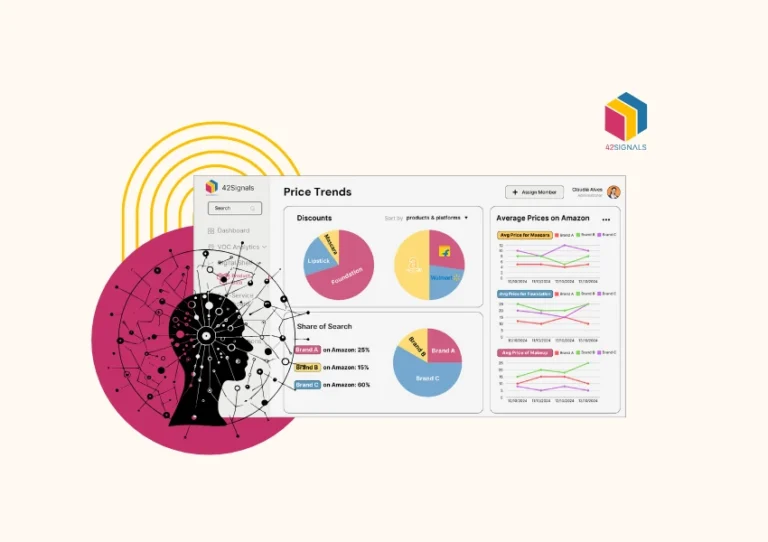Pricing holds significant importance in the ever-changing realm of eCommerce as it directly impacts the success of your online business. Striking the right balance between profitability and customer satisfaction is of utmost importance. This article will look into the fundamentals of eCommerce pricing intelligence and the significance of utilizing eCommerce pricing software to stay ahead in a fiercely competitive market.
Understanding the Basics of eCommerce Pricing Intelligence
When it comes to eCommerce pricing intelligence, having a solid understanding of the basics is essential for running a successful online business. Pricing your products effectively can significantly impact your sales, customer satisfaction, and overall profitability. It’s important to recognize that pricing is not simply assigning arbitrary numbers to your products. Instead, it involves a strategic approach that takes into account various factors.
Two common pricing strategies in eCommerce are cost-based pricing and value-based pricing.
a) Cost-based pricing involves determining the production costs, overhead expenses, and desired profit margins to set the price of your products. While this approach provides a straightforward method, it may overlook crucial aspects such as market demand and customer perception of value.
b) Value-based pricing focuses on the perceived value of your products in the eyes of your target customers. This strategy involves understanding your customers’ preferences, pain points, and their willingness to pay for the value your products offer. By aligning your pricing with the perceived value, you can attract customers and maximize your profits.
In addition to the pricing strategy, there are several factors to consider when setting the prices for your eCommerce products.
Factors to Consider When Pricing Your eCommerce Products
1. Market analysis
- Study and analyze your competitors’ strategies to gather ecommerce pricing intelligence.
- Stay informed about the latest market trends and customer preferences.
- Identify opportunities for differentiation and competitive pricing.
2. Target audience
- Segment your customers based on demographics, preferences, and buying behavior.
- Determine the price sensitivity of each customer segment.
- Tailor pricing to match customers’ purchasing power and willingness to pay.
3. Cost considerations
- Calculate the production costs, overhead expenses, and desired profit margins.
- Take into account any fixed or variable costs associated with your products.
- Ensure that your pricing covers all expenses while maintaining profitability.
4. Value proposition
- Clearly communicate the unique value and benefits your products offer.
- Highlight features, quality, and advantages that differentiate your offerings.
- Convey the value proposition effectively through product descriptions and marketing messages.
5. Competitive positioning
- Position your products in the market relative to your competitors.
- Determine if you want to be a price leader, offering the lowest prices, or if you want to differentiate based on other factors with the help of eCommerce pricing intelligence software.
- Assess the perceived value your products provide compared to competitors.
6. Customer feedback
- Gather and analyze customer feedback on pricing.
- Monitor reviews, surveys, and customer support interactions.
- Adjust your pricing based on customer sentiments and preferences.
7. Seasonality and demand fluctuations
- Consider the impact of seasonal trends and fluctuations in customer demand.
- Adjust pricing during peak seasons or events to optimize sales.
- Utilize dynamic pricing strategies to respond to changing market conditions.
8. Profitability and business goals
- Set pricing that ensures profitability for your business.
- Define your desired profit margins and revenue targets.
- Regularly assess and evaluate the financial impact of your pricing strategy.
Staying Ahead in the eCommerce Market with eCommerce Pricing Intelligence
eCommerce pricing intelligence offers several advantages for staying ahead in the eCommerce market:
Real-time market analysis:
Access real-time data on market trends, competitor pricing, and customer behavior to make informed pricing decisions.
Competitive intelligence:
Gain insights into competitors’ pricing strategies, identify gaps, and adjust pricing dynamically to maintain a competitive edge.
Automated pricing updates:
Automate price adjustments across your product catalog for accuracy and consistency across sales channels.
Dynamic pricing capabilities:
Adjust prices based on real-time data, and market conditions, and optimize for maximum sales and profitability.
Pricing optimization:
Leverage algorithms and machine learning to analyze data and identify pricing patterns for different customer segments and sales channels.
Personalization and segmentation:
Tailor pricing to specific customer groups, offering personalized pricing based on preferences and purchase history.
Competitive pricing experiments:
Test different pricing strategies, promotions, and bundling to gauge customer response and optimize conversions.
Data-driven decision-making:
Utilize actionable insights and analytics to inform pricing strategies and optimize profitability.
With eCommerce pricing intelligence software, businesses can make data-driven pricing decisions, automate processes, and gain a competitive advantage in the dynamic eCommerce market.
Pricing Optimization Techniques for Higher Conversions and Profitability
Implementing effective pricing optimization techniques is essential for achieving higher conversions and profitability in your eCommerce business.
Pricing segmentation:
Pricing segmentation optimizes conversions and profitability by tailoring pricing strategies to customer segments based on demographics, buying behavior, and price sensitivity. This approach offers differentiated prices and discounts that resonate with each segment’s preferences and purchasing power, maximizing revenue by appealing to their specific needs and motivations.
Psychological pricing:
Psychological pricing techniques profoundly influence customer perception of value and boost conversions. Strategies like charm pricing (e.g., $9.99 instead of $10) create the perception of a lower price, increasing the likelihood of purchase. Bundle pricing, offering discounts for multiple product purchases, entices customers to increase order value. Experimenting with these strategies identifies what resonates with your audience, driving higher conversions.
Promotions and discounts:
Strategic promotions and discounts boost conversions and profitability. Limited-time offers, flash sales, and product-specific discounts create urgency and incentivize immediate purchases. Tiered pricing or volume discounts encourage customers to buy more, increasing average order value and overall profitability. Monitoring the effectiveness of promotions allows for strategy refinement and optimization of their impact on conversions and profitability.
Monitor and analyze competitor pricing:
Monitoring competitors’ pricing is crucial for competitiveness. By analyzing their pricing, you make informed decisions and adjust prices accordingly. Understanding price comparisons helps position your offerings effectively. Emphasizing unique value propositions beyond price attracts customers and maintains profitability, even with slightly higher prices.
Test and iterate:
Continuous testing and iteration optimize pricing strategies. A/B testing compares different models, discounts, or promotions to identify those yielding high conversions and profitability. Monitoring pricing changes’ impact on conversions, revenue, and profitability enables data-driven decisions and strategy refinement. Testing and iterating keep pricing aligned with target market preferences, keeping you ahead in the competitive eCommerce pricing intelligence landscape.
Conclusion
With a wide range of pricing software options available in the market, it’s essential to carefully consider several factors to make an informed decision that aligns with your specific business needs.
1. Evaluating the specific features and functionalities offered by different pricing software solutions is crucial. Look for software that provides real-time market analysis, competitor price monitoring, dynamic pricing capabilities, and pricing optimization tools.
2. Consider the scalability, flexibility, and usability of the pricing software. As your online business grows and evolves, you need software that can accommodate increasing product ranges, customer segments, and pricing complexities. Look for software that offers seamless integration with your existing eCommerce platforms, inventory management systems, and other relevant tools.
By carefully considering these factors and selecting the right eCommerce pricing software, you can empower your business with the tools and insights needed to stay competitive, optimize pricing strategies, and achieve long-term success in the ever-evolving eCommerce landscape.
Choosing the appropriate eCommerce pricing intelligence software is a critical decision that can greatly impact the effectiveness of your pricing strategies and contribute to the overall success of your online business. So, choose a software solution that aligns with your business goals and provides the necessary features, scalability, usability, and support to effectively drive your pricing decisions and maximize your profitability.





